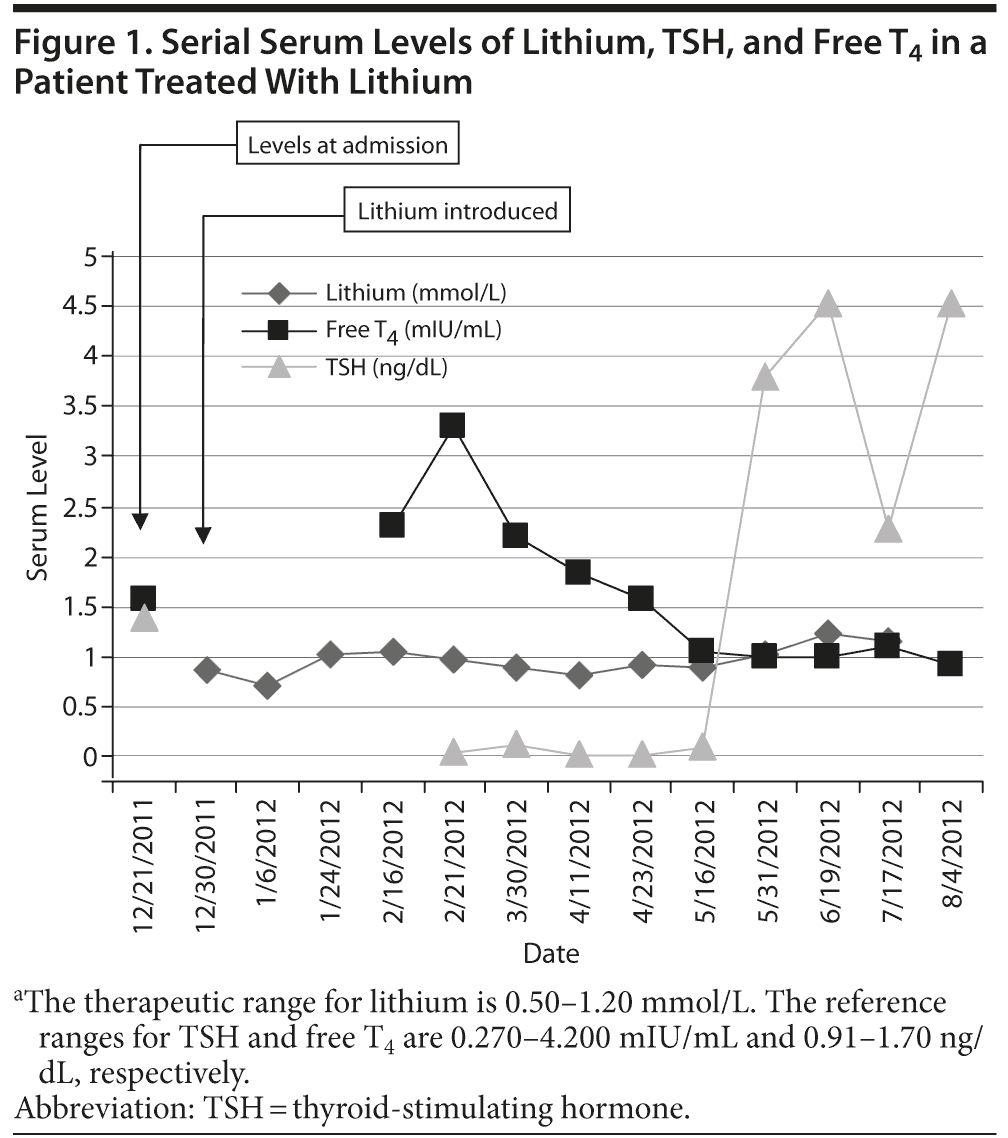Lithium-Induced Transient Euthyroid Hyperthyroxinemia: A Case Report
To the Editor: Sixty years after its introduction, lithium remains a first-line medication in the treatment of bipolar disorder.1 While lithium treatment has been associated with a wide range of adverse effects,2,3 thyroid-related abnormalities, especially hypothyroidism, are the most commonly reported ones.4,5 Lithium-associated hyperthyroidism, however, is quite rare, and only a few sporadic case reports of thyrotoxicosis that developed after several years of lithium therapy or after stopping lithium3,6 are described in the literature. Lithium-induced euthyroid hyperthyroxinemia, described as an elevation in serum thyroid hormone levels without clinical manifestations of thyrotoxicosis,7 has not been reported to our knowledge. Stratakis and Chrousos8 described a case of transient euthyroid hyperthyroxinemia associated with discontinuation of chronic lithium treatment. We report a patient who developed transient euthyroid hyperthyroxinemia within a few weeks of initiation of lithium therapy.
Case report. Ms A, a 24-year-old African American woman with a 4-year history of schizoaffective disorder, bipolar type (DSM-IV-TR), was admitted to our hospital in December 2011 with signs and symptoms consistent with mania with psychosis. At admission, she presented with a labile mood with aggressive and violent behavior, insomnia, poor concentration, pressured speech with racing thoughts, and increased psychomotor activity. She was also very paranoid, reported auditory hallucinations, and was often found responding to internal stimuli. She had no acute medical findings, except for past history of gastroesophageal reflux/dyspepsia symptoms and urinary urgency. She had never been pregnant, and her family history was negative for thyroid abnormalities. Her admission laboratory workup, including thyroid function, was unremarkable except for elevated serum total creatine kinase level of 574 U/L (normal range, 26-140 U/L), which subsequently normalized. She was started on lithium carbonate titrated to 900 mg daily, risperidone, and clonazepam. Under this regimen, her mood and psychotic symptoms started to improve. Serum lithium, free T4, and thyroid-stimulating hormone (TSH) levels were serially monitored over the course of her hospitalization (Figure 1).
About 2.5 months after treatment initiation, we noticed an elevation in her free T4 levels with a slight decrease in TSH levels. During this period, she remained clinically euthyroid with no evidence of thyrotoxicosis. A full hyperthyroidism workup revealed the following: an elevated serum total thyroglobulin level over 180 ng/mL (normal range, 1.2-35 ng/mL), thyroid antibody levels within normal limits, no evidence of a thyroid nodule on ultrasonogram, a 0.9% I123 uptake at 4 hours (normal, 5%-15%) and a 0.3% uptake at 24 hours (normal, 5%-15%) on a thyroid uptake scan, and no evidence suggestive of an ectopic thyroid tissue. Lithium therapy was continued with careful monitoring for evidence of thyrotoxicosis. Elevation of free T4 and associated drop in TSH levels persisted for the next 2 months (Figure 1). During the fourth month of treatment, free T4 levels returned to within normal limits.
The incidence of transient euthyroid hyperthyroxinemia in acute psychiatric inpatients at admission has been reported to be at 9%-18%.7 The subject in the present report had normal TSH and T4 levels at admission. To our knowledge, this is the first reported case of lithium-induced transient euthyroid hyperthyroxinemia. Although the role of lithium in thyroid hormone synthesis and release has been extensively investigated and reviewed,9 how it may induce euthyroid hyperthyroxinemia is unclear. From a clinical perspective, if a clinician finds elevated thyroxine levels in the absence of overt thyrotoxicosis in a patient started on lithium therapy, it would seem prudent to carefully monitor clinically for development of thyrotoxic symptoms without immediately resorting to an extensive and expensive diagnostic workup.
References
1. American Psychiatric Association. Practice guideline for the treatment of patients with bipolar disorder (revision). Am J Psychiatry. 2002;159(4 suppl):1-50. PubMed
2. McKnight RF, Adida M, Budge K, et al. Lithium toxicity profile: a systematic review and meta-analysis. Lancet. 2012;379(9817):721-728. PubMed doi:10.1016/S0140-6736(11)61516-X
3. Livingstone C, Rampes H. Lithium: a review of its metabolic adverse effects. J Psychopharmacol. 2006;20(3):347-355. PubMed doi:10.1177/0269881105057515
4. Kibirige D, Luzinda K, Ssekitoleko R. Spectrum of lithium induced thyroid abnormalities: a current perspective. Thyroid Res. 2013;6(1):3.
5. Bocchetta A, Loviselli A. Lithium treatment and thyroid abnormalities. Clin Pract Epidemiol Ment Health. 2006;12;(2):23.PubMed
6. Bou Khalil R, Richa S. Thyroid adverse effects of psychotropic drugs: a review. Clin Neuropharmacol. 2011;34(6):248-255. PubMed doi:10.1097/WNF.0b013e31823429a7
7. Borst GC, Eil C, Burman KD. Euthyroid hyperthyroxinemia. Ann Intern Med. 1983;98(3):366-378. PubMed doi:10.7326/0003-4819-98-3-366
8. Stratakis CA, Chrousos GP. Transient elevation of serum thyroid hormone levels following lithium discontinuation. Eur J Pediatr. 1996;155(11):939-941. PubMed doi:10.1007/BF02282883
9. Lazarus JH. Lithium and thyroid. Best Pract Res Clin Endocrinol Metab. 2009;23(6):723-733. PubMed doi:10.1016/j.beem.2009.06.002
Author affiliations: Department of Psychiatry, University of Arkansas for Medical Sciences, Little Rock.
Potential conflicts of interest: None reported.
Funding/support: None reported.
Published online: April 24, 2014.
Prim Care Companion CNS Disord 2014;16(2):doi:10.4088/PCC.13l01604
© Copyright 2014 Physicians Postgraduate Press, Inc.






